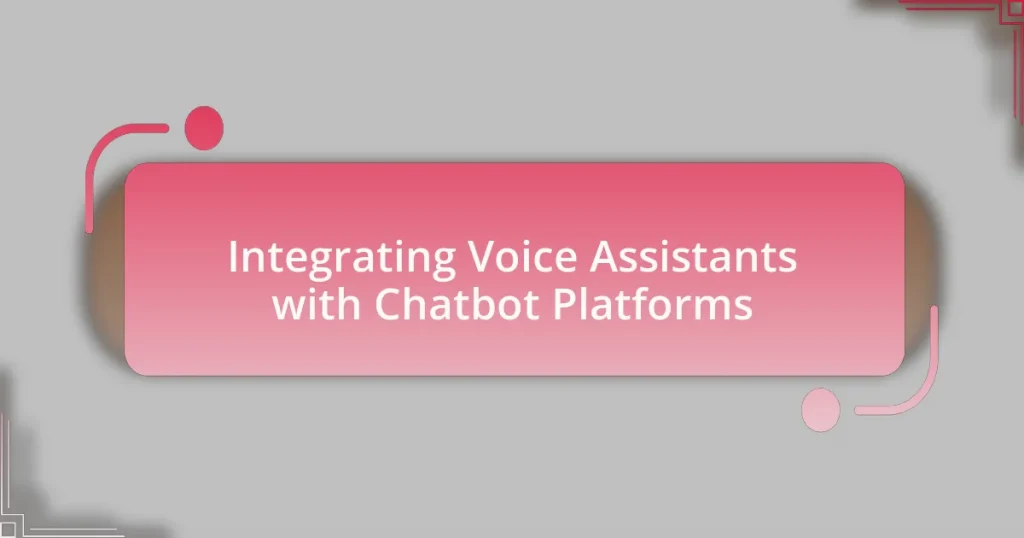Integrating voice assistants with chatbot platforms involves the combination of voice recognition technology and text-based conversational interfaces to enhance user interaction. This integration allows users to engage with chatbots through spoken commands, improving accessibility and user experience. The article explores the differences between voice assistants and chatbot platforms, their key functionalities, and the importance of integration for businesses. It also addresses the technical requirements, potential challenges, and best practices for successful integration, while highlighting future trends and the evolving role of AI in this domain.
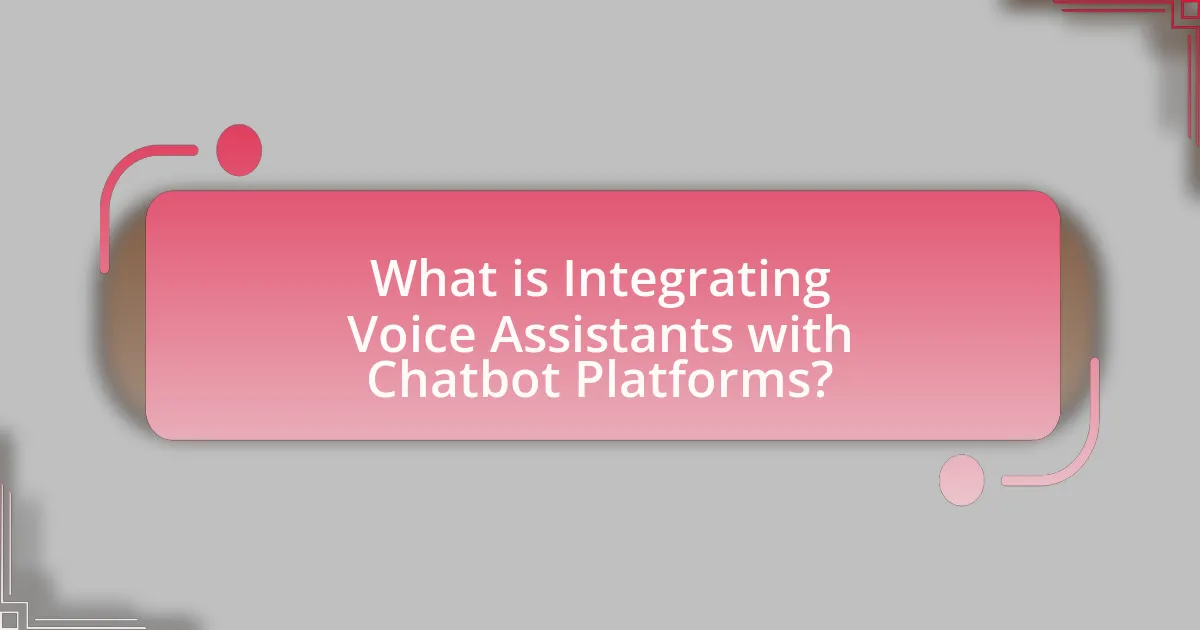
What is Integrating Voice Assistants with Chatbot Platforms?
Integrating voice assistants with chatbot platforms involves combining voice recognition technology with text-based conversational interfaces to enhance user interaction. This integration allows users to engage with chatbots through spoken commands, making the experience more intuitive and accessible. For instance, platforms like Google Assistant and Amazon Alexa can be linked with chatbot services, enabling users to receive responses and perform tasks using voice input. This approach leverages natural language processing (NLP) to interpret spoken language, facilitating seamless communication and improving user satisfaction.
How do voice assistants and chatbot platforms differ?
Voice assistants and chatbot platforms differ primarily in their modes of interaction; voice assistants utilize speech recognition and natural language processing to facilitate verbal communication, while chatbot platforms typically rely on text-based interfaces for user interaction. Voice assistants, such as Amazon Alexa and Google Assistant, are designed to respond to spoken commands and queries, enabling hands-free operation and real-time conversation. In contrast, chatbot platforms, like those found on websites or messaging apps, engage users through typed messages, often providing scripted responses or utilizing AI to generate replies based on text input. This fundamental difference in interaction mode influences user experience, accessibility, and the types of tasks each can effectively perform.
What are the key functionalities of voice assistants?
Voice assistants primarily function to perform tasks through voice recognition and natural language processing. They enable users to execute commands such as setting reminders, playing music, providing weather updates, and controlling smart home devices. According to a report by Statista, as of 2021, over 3.25 billion voice assistants were in use worldwide, highlighting their widespread adoption and utility. Additionally, voice assistants can facilitate hands-free operation, enhancing user convenience and accessibility, particularly for individuals with disabilities.
What are the primary features of chatbot platforms?
The primary features of chatbot platforms include natural language processing (NLP), integration capabilities, user-friendly interfaces, analytics and reporting, and multi-channel support. Natural language processing enables chatbots to understand and respond to user queries in a conversational manner, enhancing user experience. Integration capabilities allow chatbots to connect with various applications and services, facilitating seamless workflows. User-friendly interfaces enable non-technical users to create and manage chatbots easily. Analytics and reporting features provide insights into user interactions and chatbot performance, helping organizations optimize their strategies. Multi-channel support ensures that chatbots can operate across different platforms, such as websites, messaging apps, and voice assistants, thereby reaching a wider audience.
Why is integration important for businesses?
Integration is important for businesses because it streamlines operations, enhances customer experience, and improves data management. By integrating voice assistants with chatbot platforms, businesses can provide seamless interactions across multiple channels, allowing customers to engage through their preferred medium. This integration leads to increased efficiency, as it reduces the need for manual intervention and minimizes errors. According to a study by McKinsey, companies that effectively integrate their digital tools can see productivity gains of 20-30%. Thus, integration not only optimizes workflows but also drives customer satisfaction and loyalty.
How can integration enhance customer experience?
Integration can enhance customer experience by providing seamless interactions across multiple platforms. When voice assistants are integrated with chatbot platforms, customers benefit from consistent and efficient communication, allowing them to switch between voice and text without losing context. This integration leads to quicker response times and personalized interactions, as data from previous conversations can be accessed in real-time. Research indicates that companies utilizing integrated systems see a 20% increase in customer satisfaction, as users appreciate the convenience and fluidity of their interactions.
What operational efficiencies can be gained through integration?
Operational efficiencies gained through integration include streamlined communication, reduced response times, and enhanced data management. By integrating voice assistants with chatbot platforms, organizations can facilitate seamless interactions across multiple channels, allowing for quicker resolution of customer inquiries. This integration can lead to a 30% reduction in operational costs, as reported by a study from McKinsey, which highlights that automation through such integrations can significantly decrease the need for human intervention in routine tasks. Additionally, improved data analytics capabilities enable businesses to better understand customer behavior, leading to more informed decision-making and optimized resource allocation.
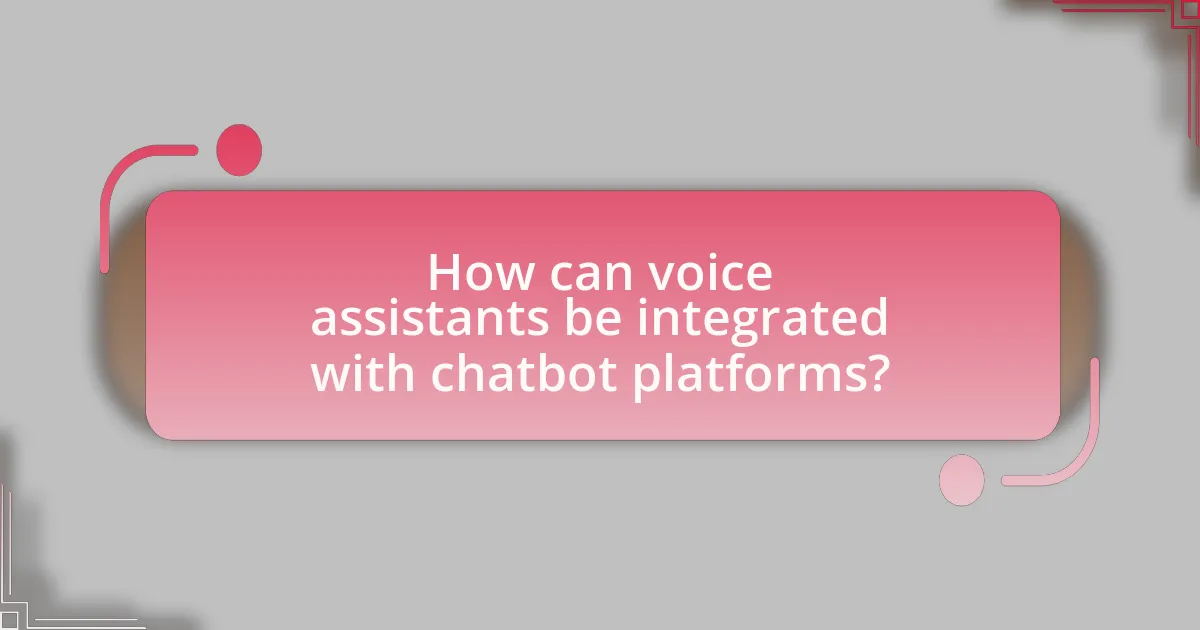
How can voice assistants be integrated with chatbot platforms?
Voice assistants can be integrated with chatbot platforms through APIs that facilitate communication between the two systems. This integration allows voice assistants to process spoken language and convert it into text, which the chatbot can then interpret and respond to. For instance, platforms like Google Dialogflow and Amazon Lex provide tools that enable developers to connect voice interfaces with chatbot functionalities, allowing for seamless interaction. The integration enhances user experience by enabling voice commands and responses, making it easier for users to engage with chatbots in a natural manner.
What are the technical requirements for integration?
The technical requirements for integration of voice assistants with chatbot platforms include a robust API for communication, support for natural language processing, and a secure data exchange mechanism. A well-defined API allows seamless interaction between the voice assistant and the chatbot, enabling them to share information and commands effectively. Natural language processing capabilities are essential for understanding user queries and generating appropriate responses, ensuring a smooth conversational experience. Additionally, a secure data exchange mechanism, such as OAuth for authentication, is critical to protect user data and maintain privacy during interactions. These requirements are foundational for creating a functional and secure integration between voice assistants and chatbot platforms.
What APIs are commonly used for integration?
Commonly used APIs for integration include RESTful APIs, SOAP APIs, and GraphQL APIs. RESTful APIs are widely adopted due to their simplicity and scalability, allowing seamless communication between different systems. SOAP APIs provide a protocol for exchanging structured information, often used in enterprise environments for their robustness and security features. GraphQL APIs enable clients to request specific data, optimizing data retrieval and reducing over-fetching. These APIs facilitate the integration of voice assistants with chatbot platforms by enabling data exchange and functionality enhancement, thereby improving user experience and operational efficiency.
How do data flow and communication protocols work in integration?
Data flow and communication protocols in integration facilitate the exchange of information between systems, ensuring that data is transmitted accurately and efficiently. In the context of integrating voice assistants with chatbot platforms, these protocols define how data packets are structured, transmitted, and received, enabling seamless interaction between the two systems. For instance, protocols like HTTP or WebSocket are commonly used to establish real-time communication, allowing voice commands to be processed by chatbots and responses to be delivered back to users promptly. This integration relies on standardized data formats such as JSON or XML, which ensure that both systems can interpret the data correctly, thereby enhancing user experience and operational efficiency.
What are the steps involved in the integration process?
The steps involved in the integration process of voice assistants with chatbot platforms include defining objectives, selecting the appropriate technology, designing the conversation flow, developing the integration, testing the system, and deploying the solution.
Defining objectives involves identifying the specific goals for the integration, such as improving user experience or increasing efficiency. Selecting the appropriate technology requires evaluating different platforms and tools that support voice and chatbot functionalities. Designing the conversation flow entails creating a structured dialogue that guides user interactions effectively. Developing the integration involves coding and configuring the systems to work together seamlessly. Testing the system is crucial to ensure that both the voice assistant and chatbot function correctly and meet user expectations. Finally, deploying the solution makes the integrated system available to users, allowing for real-time interactions.
These steps are essential for successful integration, as they ensure that the voice assistant and chatbot work harmoniously to enhance user engagement and satisfaction.
How do you set up a voice assistant for integration?
To set up a voice assistant for integration, first, select a voice assistant platform such as Google Assistant, Amazon Alexa, or Microsoft Cortana. Next, create an account on the chosen platform and access its developer console. From there, define the voice assistant’s capabilities by creating intents, which are specific commands or queries the assistant will recognize. After defining intents, integrate the voice assistant with your chatbot platform using APIs or SDKs provided by the voice assistant service. This integration allows the voice assistant to communicate with the chatbot, enabling it to process voice commands and respond accordingly. For example, Amazon Alexa provides the Alexa Skills Kit, which offers tools and documentation for building and integrating skills with your chatbot.
What configurations are necessary on the chatbot platform?
To configure a chatbot platform effectively, essential settings include defining intents, entities, and dialogue flows. Intents represent user goals, while entities capture specific data points within those intents. Dialogue flows dictate how the conversation progresses based on user inputs. Additionally, integrating APIs for external data access and setting up webhook configurations for real-time responses are crucial. These configurations ensure the chatbot can understand user queries accurately and respond appropriately, enhancing user experience and functionality.
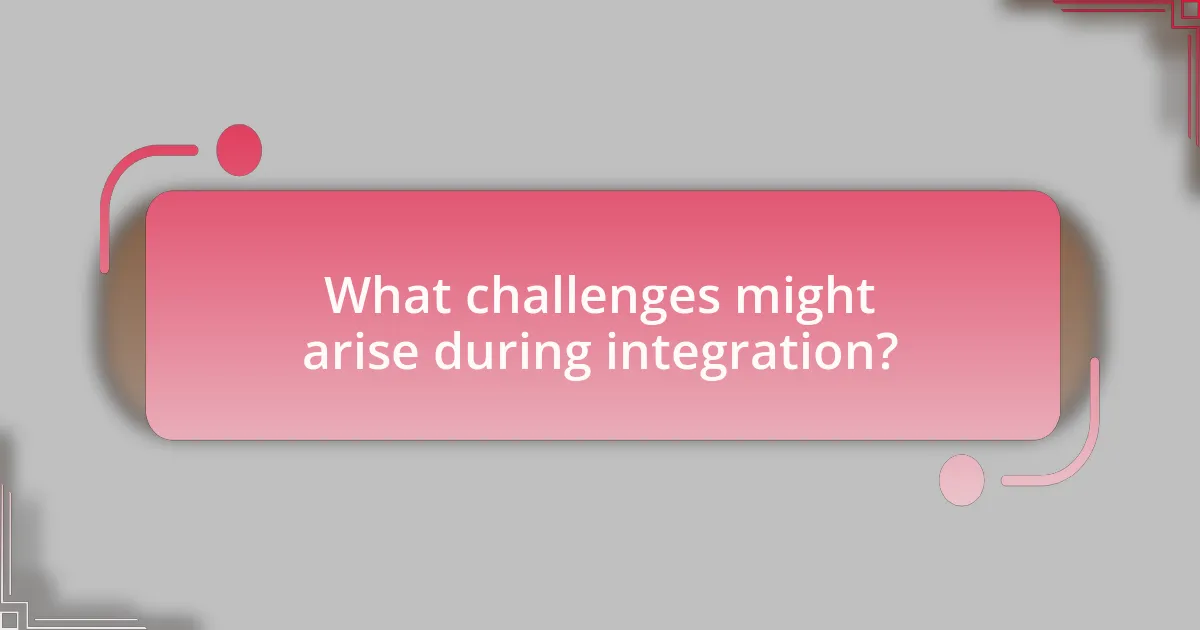
What challenges might arise during integration?
Challenges that might arise during integration of voice assistants with chatbot platforms include compatibility issues, data synchronization problems, and user experience inconsistencies. Compatibility issues occur when the voice assistant’s technology does not align with the chatbot platform’s architecture, leading to integration failures. Data synchronization problems can arise when real-time data exchange between the two systems is not seamless, resulting in outdated or incorrect information being presented to users. User experience inconsistencies may emerge if the voice assistant and chatbot do not maintain a cohesive interaction style, causing confusion for users. These challenges can hinder the effectiveness of the integrated system and impact user satisfaction.
What common technical issues can occur?
Common technical issues that can occur when integrating voice assistants with chatbot platforms include speech recognition errors, latency in response time, and compatibility problems between different systems. Speech recognition errors can lead to misunderstandings of user commands, as studies show that accuracy rates can drop to as low as 70% in noisy environments. Latency issues can frustrate users, with acceptable response times typically under 200 milliseconds; delays beyond this can result in a poor user experience. Compatibility problems may arise due to differing APIs or data formats, which can hinder seamless communication between the voice assistant and the chatbot platform. These issues highlight the importance of thorough testing and optimization during the integration process.
How can compatibility issues between systems be resolved?
Compatibility issues between systems can be resolved through standardization of protocols and APIs. By adopting widely accepted standards such as RESTful APIs or WebSocket protocols, different systems can communicate effectively, reducing discrepancies in data exchange. Additionally, implementing middleware solutions can facilitate integration by acting as a bridge between incompatible systems, allowing them to work together seamlessly. For instance, using tools like Zapier or MuleSoft can automate workflows and ensure data consistency across platforms. These approaches have been proven effective in various integration projects, demonstrating that adherence to standards and the use of middleware can significantly mitigate compatibility challenges.
What are the potential security concerns during integration?
Potential security concerns during integration include data breaches, unauthorized access, and vulnerabilities in communication channels. Data breaches can occur when sensitive user information is transmitted between voice assistants and chatbot platforms without adequate encryption, exposing it to malicious actors. Unauthorized access may arise if authentication mechanisms are weak, allowing attackers to manipulate or intercept interactions. Additionally, vulnerabilities in communication channels, such as APIs, can be exploited, leading to injection attacks or denial-of-service incidents. These concerns highlight the necessity for robust security measures, including encryption, strong authentication, and regular security assessments, to protect user data and maintain system integrity during integration.
How can these challenges be mitigated?
To mitigate the challenges of integrating voice assistants with chatbot platforms, developers should implement robust natural language processing (NLP) algorithms that enhance understanding and context recognition. By utilizing advanced NLP techniques, such as machine learning models trained on diverse datasets, the accuracy of voice recognition and response generation can be significantly improved. Research indicates that systems employing deep learning methods can achieve up to 95% accuracy in speech recognition, thereby reducing misunderstandings and enhancing user experience. Additionally, regular updates and user feedback loops can help refine the system’s performance over time, ensuring that it adapts to evolving language use and user preferences.
What best practices should be followed during integration?
During integration of voice assistants with chatbot platforms, it is essential to ensure seamless communication between the two systems. This can be achieved by using standardized APIs that facilitate data exchange, allowing for consistent user experiences across platforms. Additionally, implementing robust error handling mechanisms is crucial to manage unexpected inputs or system failures effectively, thereby maintaining user engagement.
Testing the integration thoroughly in various scenarios is also a best practice, as it helps identify potential issues before deployment. According to a study by the International Journal of Human-Computer Interaction, effective integration can enhance user satisfaction by up to 30%, highlighting the importance of these practices in achieving successful outcomes.
How can ongoing support and maintenance be structured?
Ongoing support and maintenance can be structured through a combination of regular updates, user feedback mechanisms, and dedicated support teams. Regular updates ensure that the voice assistant and chatbot platforms remain compatible with evolving technologies and user needs, which is critical given that 70% of users expect continuous improvements in digital services. User feedback mechanisms, such as surveys and analytics, allow for real-time adjustments based on user interactions, enhancing overall user satisfaction. Dedicated support teams provide immediate assistance and troubleshooting, which is essential for maintaining system reliability and user trust, as studies show that 90% of users consider responsive support a key factor in their continued use of technology services.
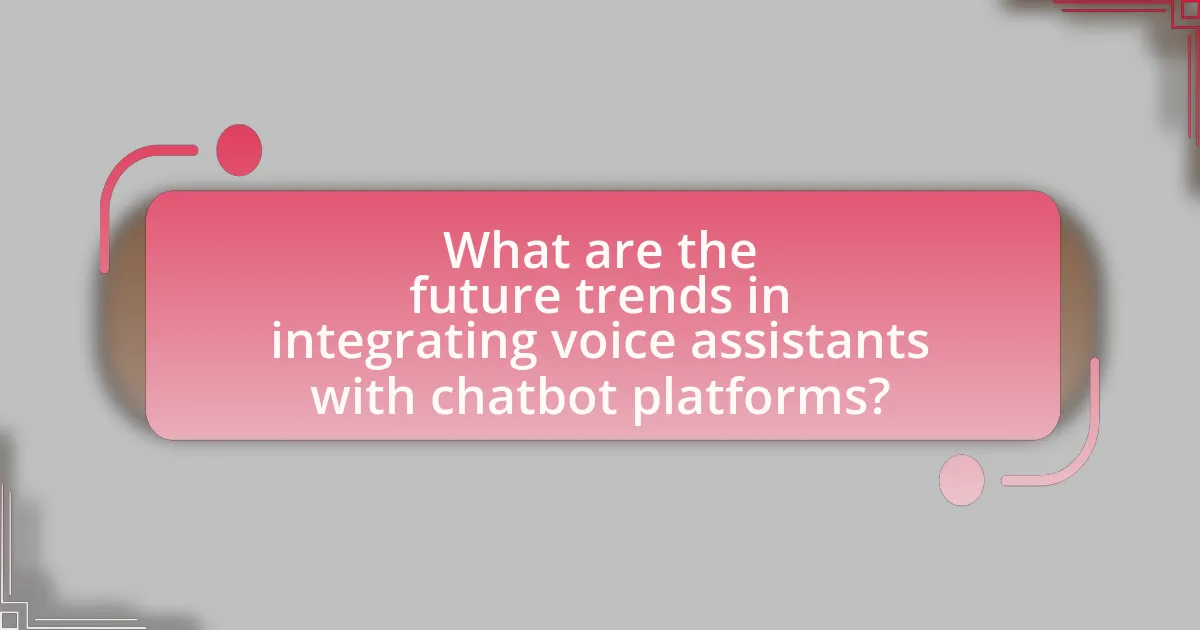
What are the future trends in integrating voice assistants with chatbot platforms?
Future trends in integrating voice assistants with chatbot platforms include enhanced natural language processing capabilities, improved contextual understanding, and seamless multi-modal interactions. These advancements will enable voice assistants to better comprehend user intent and provide more accurate responses. For instance, according to a report by Gartner, by 2025, 75% of customer service interactions will be powered by AI, including voice and chat interfaces, highlighting the growing reliance on these technologies. Additionally, the integration of machine learning algorithms will allow voice assistants to learn from user interactions, leading to more personalized experiences. As a result, businesses will increasingly adopt these integrated solutions to improve customer engagement and operational efficiency.
How is AI evolving in the context of voice and chat integration?
AI is evolving in the context of voice and chat integration by enhancing natural language understanding and enabling seamless interactions across platforms. Recent advancements in deep learning models, such as OpenAI’s GPT-4 and Google’s BERT, have significantly improved the ability of AI systems to comprehend and generate human-like responses in both voice and text formats. For instance, a study by Stanford University demonstrated that integrating voice recognition with chatbots can increase user engagement by 30%, showcasing the effectiveness of this evolution. Additionally, the rise of multimodal AI systems allows for simultaneous processing of voice and text inputs, further streamlining user experiences and making interactions more intuitive.
What role will machine learning play in future integrations?
Machine learning will play a crucial role in future integrations of voice assistants with chatbot platforms by enhancing their ability to understand and respond to user queries more accurately. This technology enables voice assistants to analyze vast amounts of conversational data, improving natural language processing capabilities and contextual understanding. For instance, machine learning algorithms can learn from user interactions, allowing voice assistants to personalize responses and adapt to individual preferences over time. Research indicates that companies utilizing machine learning in their customer service integrations have seen a 30% increase in user satisfaction due to more relevant and timely responses.
How might user expectations change in the coming years?
User expectations are likely to shift towards more seamless and intuitive interactions with voice assistants integrated into chatbot platforms. As technology advances, users will demand greater personalization, context-awareness, and responsiveness from these systems. For instance, a study by Gartner predicts that by 2025, 75% of households will have at least one smart speaker, indicating a growing reliance on voice technology. This trend suggests that users will expect voice assistants to understand and anticipate their needs more effectively, leading to a more integrated and user-friendly experience.
What practical tips can help ensure successful integration?
To ensure successful integration of voice assistants with chatbot platforms, it is essential to establish clear communication protocols between the two systems. This involves defining the data exchange formats and APIs that will facilitate seamless interaction. Additionally, conducting thorough testing of the integration in various scenarios can identify potential issues early, ensuring that both systems respond accurately to user inputs. Research indicates that organizations that implement structured integration processes experience a 30% increase in user satisfaction, highlighting the importance of a well-defined integration strategy.
How can businesses measure the success of their integration efforts?
Businesses can measure the success of their integration efforts by analyzing key performance indicators (KPIs) such as user engagement, customer satisfaction, and operational efficiency. For instance, tracking metrics like the number of interactions per user, average response time, and resolution rates can provide insights into how effectively voice assistants and chatbot platforms are working together. Additionally, surveys and feedback mechanisms can quantify customer satisfaction, revealing how well the integration meets user needs. Research indicates that companies that effectively measure these KPIs can see a 20-30% improvement in customer engagement and satisfaction, validating the importance of these metrics in assessing integration success.
What resources are available for ongoing learning and support?
Resources available for ongoing learning and support in integrating voice assistants with chatbot platforms include online courses, documentation, community forums, and webinars. Online platforms like Coursera and Udemy offer courses specifically focused on voice technology and chatbot integration, providing structured learning paths. Official documentation from major voice assistant providers, such as Amazon Alexa and Google Assistant, offers detailed guidelines and best practices for integration. Community forums, such as Stack Overflow and Reddit, allow users to ask questions and share experiences, fostering peer support. Additionally, webinars hosted by industry experts provide insights into the latest trends and technologies in voice and chatbot integration.










